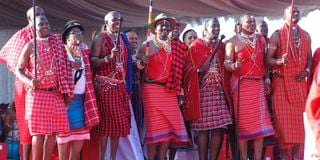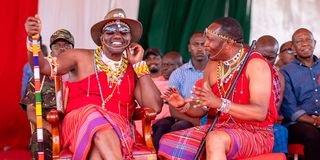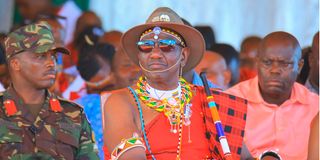Premium
Forgotten Archer’s Post town gets a lifeline, thanks to Maa Cultural Festival

President William Ruto performs a jig with other leaders during the second edition of the Maa Cultural Festival at Archer’s Post in Samburu County on November 8, 2024.
What you need to know:
- At the heart of the festival are traditional dances and cultural displays passed down through generations.
- Maa Cultural Festival also includes competitions in traditional sports like cattle roping and camel derby.
Archer’s Post, located on the Isiolo-Marsabit-Moyale highway, is a town long accustomed to being overlooked.
It has often been just a pit stop where travellers to Northern Kenya pass through without a second glance. Unknown to many, it has a rich history dating back to the pre-colonial era.
The town which has been in the news for the explosion of unexploded ordnance causing deaths and injuries among civilians is named after George Francis Archer, a British surveyor in the early 1900s.
He established the location as a military post for British colonial officials, traders and other travellers moving through northern Kenya and named it after himself.
In the 1950s, the British army used Archer’s Post as a military testing area. The town now has shops, cafes and bars dotting the roadside where trucks roar through while heading towards the Kenya-Ethiopia border, kicking up dust as they pass the scrublands.

A road signage of Archer's Post in Samburu County.
With the return of the second edition of the Maa Cultural Week this year, the humble town was in the first week of November transformed into a bustling epicentre of tradition, trade, music, dance and the colourful attire of the Maasai communities living in Samburu, Narok and Kajiado counties.
For the locals of Archer’s Post who have endured years of economic hardship, the festival is more than just a chance to dance and dress in vibrant red Maasai shukas.
It’s an opportunity to share their culture and breathe life into their town in the festivities that started on Wednesday and ended on Friday.
In an interview with Nation.Africa, 62-year-old elder and herder Samuel Lekipa reflected on what the festival has come to mean to him and his neighbours who live adjacent to the Samburu National Reserve where part of the festival extends into.
“We’ve had our struggles here... drought, poverty and young people leaving to find work in cities. The festival at least for a few days makes Archer’s Post feel alive,” he says, gesturing towards a makeshift marketplace lined with vendors selling traditional colourful beadwork, gourds, and Maasai jewellery.

President William Ruto and Samburu Governor Jonathan Lati Lelelit during the Maa Cultural Festival at Archer’s Post in Samburu County on November 8, 2024.
“This year, I’ve seen more people in town than I ever have. It’s not just a festival. It’s hope. This is what I want my grandchildren to see. Not just the struggles but the joy in our way of life. We may not have much, but when we come together like this, we are rich in ways outsiders might never understand,” Lekipa says.
For the first time, many locals and traders are seeing their crafts appreciated and paid for.
Ms Jane Tompoi, who runs a small tea house in the town, is delighted by the huge crowds.
“Normally, I’ll see maybe five to 10 customers in a day, making about Sh300 to 400. But during the festival, it’s non-stop. People come in after watching the performances and they will sit, talk, and eat. I even had to bring my niece to help serve customers because I can’t remember the last time I needed help here and made so much money,” she says while busy serving tea to festival-goers.
But the festival’s allure isn’t only in its economic impact.
The celebrations have a brought a deep sense of pride to a community that often feels overlooked because of banditry, female genital mutilation and poverty.

President William Ruto during the second edition of the Maa Cultural Festival held at Archer's Post in Samburu County on November 8, 2024.
At the heart of the festival are the traditional dances and cultural displays that have been passed down through generations.
Dressed in a striking red shuka adorned with colourful beadwork, 23-year-old Dorcas Napayian from Kajiado County explained how the festival has allowed her to explore and embrace her heritage in ways she never imagined before.
“Growing up, I sometimes felt like our traditions were only for the elders. But this festival lets us young people see the beauty in who we are. But because of this annual festival, I feel connected to my ancestors like I’m carrying on something much bigger than myself,” Ms Napayian said.
Ms Napayian, who is a jewellery maker, has also found an unexpected economic opportunity in the festival.
“I’ve sold more of my handmade pieces of handmade earrings and necklaces in the past two days than I usually do in a month. I never thought my art would be something people would pay for. This festival has given me hope and shown me that I can make a living here, close to my roots,” she said.
The festival also includes competitions in traditional sports like cattle roping and camel derby which has become a major crowd-puller.

Participants compete in a camel derby at the second-edition of the Maa Cultural Festival at Archer’s Post in Samburu County on November 8, 2024.
On the edges of the festival grounds, children play dressed in miniature versions of traditional Maasai attire.
For 36-year-old Maria Lapara, a mother of three, the festival is a way for her children to stay connected to their roots.
“My kids don’t know the struggles we had here in Wamba, Samburu, when we were young. We used to walk for miles just to fetch water, and there were times when we hardly had anything to eat. This festival shows them where they come from and it lets them see that there’s more to life here than hardship,” she said.
The conservation aspect of the festival has also been important to the community.
As climate change affects traditional grazing patterns, residents are more conscious of preserving their lands. The festival organisers have included educational booths where visitors and locals are learning about sustainable practices like water conservation and reforestation.
“We can’t ignore what’s happening to our environment. We are also using this festival to talk about how we can sustain our way of life without damaging the resources we depend on,” said Samburu Tourism Executive Raphael Lenayiarra.
On Friday, President William Ruto closed the event. He was joined by governors from the three counties and other guests.






